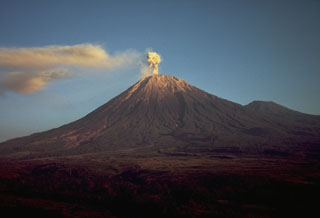Report on Semeru (Indonesia) — 25 November-1 December 2020
Smithsonian Institution / US Geological Survey
Weekly Volcanic Activity Report, 25 November-1 December 2020
Managing Editor: Sally Sennert.
Please cite this report as:
Global Volcanism Program, 2020. Report on Semeru (Indonesia) (Sennert, S, ed.). Weekly Volcanic Activity Report, 25 November-1 December 2020. Smithsonian Institution and US Geological Survey.
Semeru
Indonesia
8.108°S, 112.922°E; summit elev. 3657 m
All times are local (unless otherwise noted)
PVMBG reported that the eruption at Semeru continued during 1 October-30 November. White-and-gray ash plumes rose as high as 500 m above the summit and drifted in multiple directions. Rock avalanches were intermittently recorded starting on 19 October. A significant increase in the number rock avalanches was detected on 28 November. Pyroclastic flows originating from the ends of lava flows traveled 1 km down the SE flank. At 0123 on 1 December pyroclastic flows from the summit lava dome traveled 2-11 km down the Kobokan drainage on the SE flank. The Darwin VAAC initially reported ash plumes to 15 km (50,000 ft) a.s.l. but after further analysis noted that plumes rose to a lower altitude of 6.1 km (20,000 ft) a.s.l. and drifted SE. BNPB reported that the pyroclastic flows destroyed some mining machinery and impacted livestock, agricultural fields, and businesses. Some residents had evacuated and then returned to their homes; one person was missing. The Alert Level remained at 2 (on a scale of 1-4), with a general exclusion zone of 1 km and extensions to 4 km in the SSE sector.
Geological Summary. Semeru, the highest volcano on Java, and one of its most active, lies at the southern end of a volcanic massif extending north to the Tengger caldera. The steep-sided volcano, also referred to as Mahameru (Great Mountain), rises above coastal plains to the south. Gunung Semeru was constructed south of the overlapping Ajek-ajek and Jambangan calderas. A line of lake-filled maars was constructed along a N-S trend cutting through the summit, and cinder cones and lava domes occupy the eastern and NE flanks. Summit topography is complicated by the shifting of craters from NW to SE. Frequent 19th and 20th century eruptions were dominated by small-to-moderate explosions from the summit crater, with occasional lava flows and larger explosive eruptions accompanied by pyroclastic flows that have reached the lower flanks of the volcano.
Sources: Pusat Vulkanologi dan Mitigasi Bencana Geologi (PVMBG, also known as CVGHM), Badan Nacional Penanggulangan Bencana (BNPB), Darwin Volcanic Ash Advisory Centre (VAAC)

